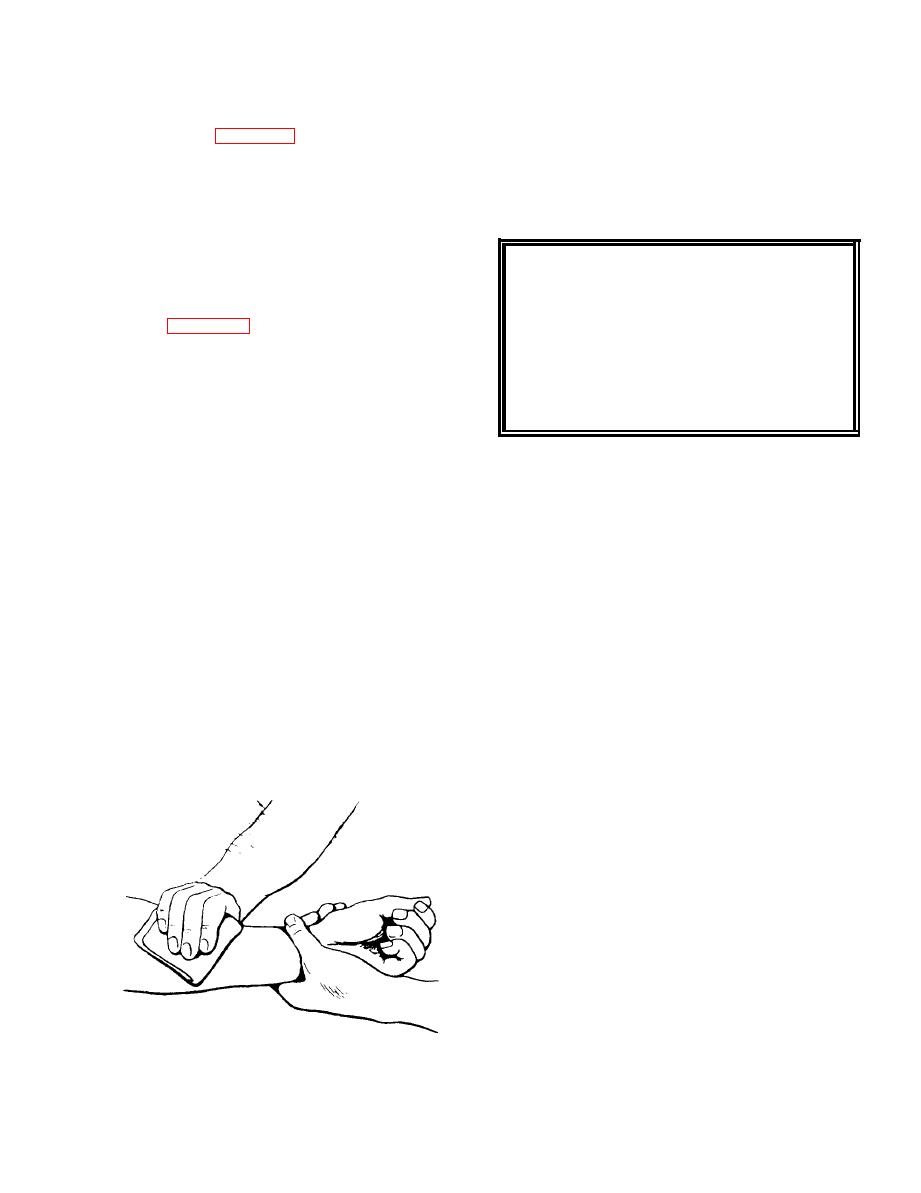 |
|||
|
|
|||
| ||||||||||
|
|
 only tight enough to stop the bleeding, and firmly
trunk-and it must be applied as close to the wound
fasten it in position with a bandage. In the absence of
as practicable.
sterile dressings, use a compress made with a clean
Any long, flat material can be used as a band for
rag, handkerchief, or towel to apply direct pressure to
a tourniquet--belts, stockings, flat strips of rubber, or
the wound, as in figure 1-14. If the bleeding does not
a neckerchief. Only tighten the tourniquet enough to
stop, firmly secure another dressing over the first
stop the flow of blood. Use a marker, skin pencil,
dressing, or apply direct pressure with your hand or
crayon, or blood, and mark a large T on the victim's
fingers over the dressing. Under no circumstances is a
forehead.
dressing to be removed once it is applied.
Pressure Points
WARNING
If the direct-pressure method does not stop the
bleeding, use the pressure point nearest the wound, as
Remember, a tourniquet is ONLY used
shown in figure 1-15. Bleeding from a cut artery or
as a last resort to control bleeding that
vein may often be controlled by applying pressure to
cannot be controlled by other means.
the appropriate pressure point. A pressure point is a
Tourniquets should be removed as soon as
place where the main artery to the injured part lies near
the skin surface and over a bone. Pressure at such a
possible by medical personnel only.
point is applied with the fingers or with the hand; no
first-aid materials are required. Pressure points should
be used with caution, as they may cause damage to the
BURNS
limb as a result of an inadequate flow of blood. When
the use of pressure points is necessary, do not
The causes of burns are generally classified as
substitute them for direct pressure; use both.
thermal, electrical, chemical, or radiation. Whatever
the cause, shock always results if the burns are
Use of a Tourniquet
extensive.
A tourniquet is a constricting band that is used to
cut off the supply of blood to an injured limb. It
Thermal burns are caused by exposure to intense
heat, such as that generated by fire, bomb flash,
cannot be used to control bleeding from the head,
neck, or body, since its use in these locations would
sunlight, hot liquids, hot solids, and hot gases. Their
result in greater injury or death. A tourniquet should
care depends upon the severity of the burn and the
be used on an injured limb only as a last resort for
percentage of the body area involved.
severe, life-threatening hemorrhaging that cannot be
controlled by any other method. A tourniquet must be
Electrical burns are caused by electric current
applied ABOVE the wound--that is, towards the
passing through tissues or the superficial wound
caused by electrical flash. They may be far more
serious than they first appear. The entrance wound
may be small; but as electricity penetrates the skin, it
burns a large area below the surface. Usually there are
two external burn areas: one where the current enters
the body, and another where it leaves.
Chemical burns for the most part are not caused by
heat, but by direct chemical destruction of body tissues.
When acids, alkalies, or other chemicals come in
contact with the skin or other body membranes, they can
cause injuries that are generally referred to as chemical
burns. The areas most often affected are the extremities,
mouth, and eyes. Alkali burns are usually more serious
than acid burns, because they penetrate deeper and
burn longer. When chemical burns occur, emergency
|
|
Privacy Statement - Press Release - Copyright Information. - Contact Us |